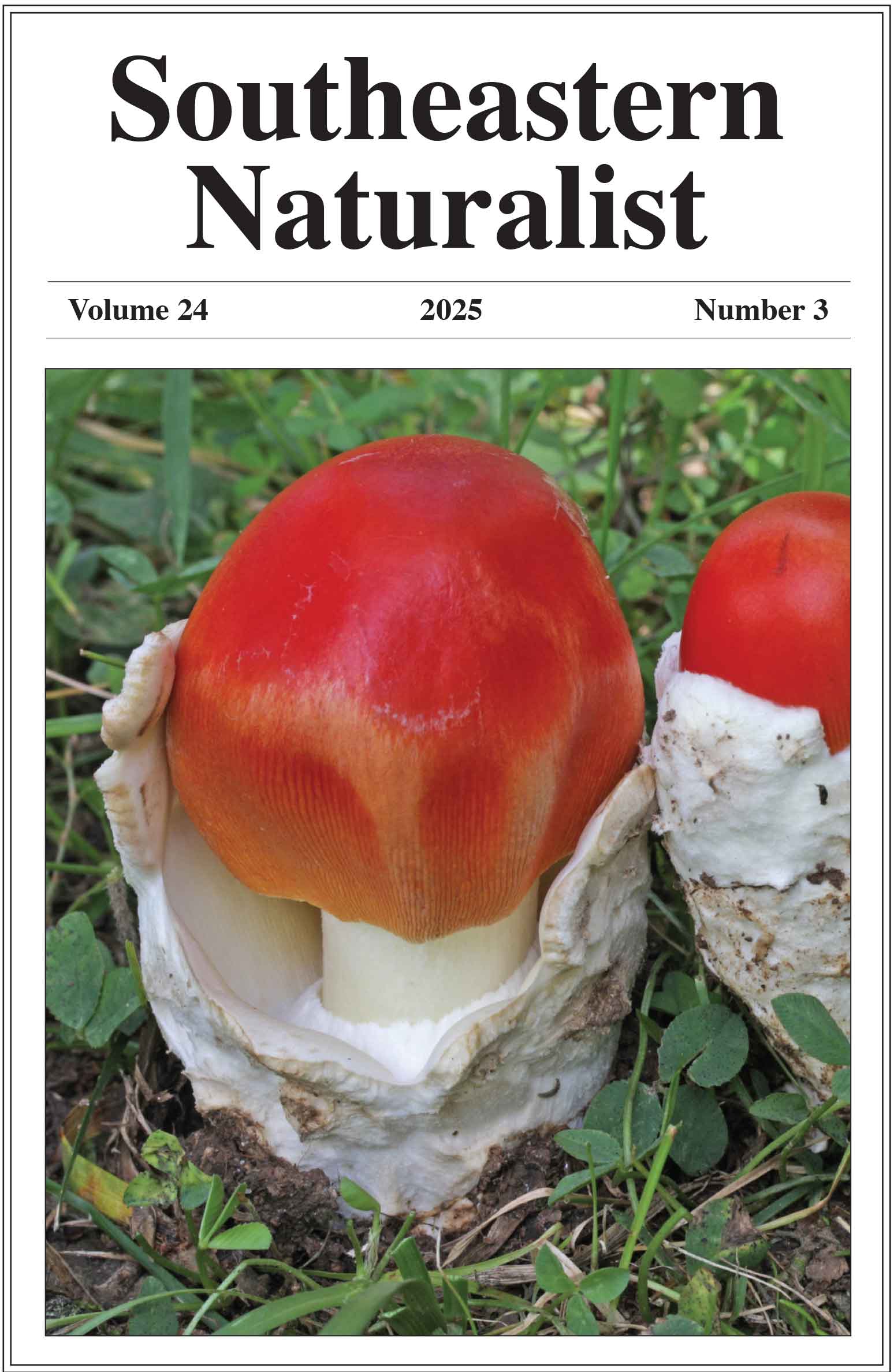2011 SOUTHEASTERN NATURALIST 10(4):703–712
Is the LCP Superfund Site an Ecological Trap for
Clapper Rails?
Karen F. Gaines1,*, Jay W. Summers1, James C. Cumbee, Jr.2,
Warren L. Stephens3, Jr., and Gary L. Mills3
Abstract - Rallus longirostris (Clapper Rail) is considered a good indicator species for
toxicants because of its strong site fidelity and predictable diet of benthic organisms. High
levels of the rare PCB Aroclor 1268 have been found in Clapper Rail adults, chicks, and
eggs from the marshes associated with the Linden Chemical Plant (LCP) in Brunswick,
GA. Recently, sampling and testing feathers has successfully been used as a non-lethal
tool to trace exposure and assimilation of Aroclor 1268 in rails from the LCP site. This
approach allows us to infer how and when these birds are exposed to contaminants in
the marsh due to predictable molting patterns coupled with the fact that a feather will
accumulate the toxicant only at the time it is grown. This study is the start of a process
to investigate the possibility that this ecosystem contamination is the foundation of an
ecological trap for Clapper Rails at the LCP site. Aroclor 1268 was isolated in Clapper
Rail feathers from all birds collected from the contaminated marsh. This finding suggests
that these birds either hatched or resided in this system the previous year and thus were
not new recruits, which would be expected if fitness was being compromised from the
contamination. Based on samples taken during the same fall and winter from the LCP site
and control areas, the ratios of hatch-year (HY) birds to adults were similar. However,
based on samples taken during the spring and summer, the ratios of HY birds to adults
from LCP were lower than reported previously in studies in the southeast. This result
suggests that the population age structure may have been affected by the contamination.
Future studies specifically focused on reproductive success and fitness are needed at LCP
and throughout the Brunswick estuary.
Introduction
Most examples of ecological traps in nature are linked to habitat selection
miscues resulting from modern agricultural activities (Best 1986, Bollinger et al.
1990), urbanization (Kolbe and Janzen 2002), and forestry practices (Angelstam
1986, Flaspohler et al. 2001). An ecological trap must (1) somehow increase the
habitat’s attractiveness, (2) decrease habitat suitability, or (3) do both concurrently
(Robertson and Hutto 2006). Ecotoxicological studies have traditionally
focused on genetic or other physiological stressor endpoints to quantify fitness,
but have not focused on the life-history cues that may endanger the organism.
Only recently has the discipline of evolutionary toxicology emerged, acknowledging
the need to include these underlying mechanisms to better understand the
broader impact to ecosystem health (Bickham and Smolen 1994, Fox 1995).
1Department of Biological Sciences, Eastern Illinois University, 600 Lincoln Avenue,
Charleston, IL 61920. 2USDA APHIS Wildlife Services, Room 200 Thompson Hall,100
Stone Boulevard, Mississippi State, MS 39762. 3University of Georgia’s Savannah River
Ecology Laboratory, PO Drawer E, Aiken SC 29802. *Corresponding author - kfgaines@
eiu.edu.
704 Southeastern Naturalist Vol. 10, No. 4
This study aims to investigate if an extreme ecosystem contamination event has
lead to an ecological trap for a Rallus longirostris Boddaert (Clapper Rail) population.
Initial responses to large contamination events around the world are designed
to address the impacts of toxicant exposure on environmental health, which in turn
focuses on acute toxicity. Clean-up plans often consider action levels to minimize
chronic toxic effects, but fail to regard the broader impacts of long-term exposure
to populations. The Clapper Rail population in this study has been used as
an indicator population for acute effects (Cumbee et al. 2008; Novak et al. 2006;
Rodriguez-Navarro et al. 2002, 2006). However, the long-term consequences of
this perturbation have not been examined. Specifically, the purpose of this study
was to determine if Clapper Rails that either bred or hatched from a Superfund site
in Brunswick GA were coming back to nest the following season.
The Linden Chemical Plant (LCP), located in the center of the Golden Isles
region of coastal Georgia (Fig. 1), was convicted of dumping 150 tons of mercury
(Hg) into Purvis Creek, a tributary of the surrounding tidal marshes, between the
mid-1980s and its closure in 1994 (Gardner 1978, USEPA 2002). In addition,
LCP purchased a polychlorinated biphenyl (PCB) mixture known as Aroclor
1268, from the sole manufacturer, Monsanto Corporation. Only a limited amount
was produced (Kannan et al. 1997), and no other chemical company purchased
it within the eastern United States, making it a direct fingerprint to the point
source of the pollution. This PCB mixture has been found at very high levels
in the marshes directly adjacent to LCP, and contamination has spread via tidal
action through the entire Brunswick estuary (Kannan et al. 1997, Novak et al.
2006). The LCP facility was declared a Superfund site after it closed in 1994
(USEPA 2002, USFWS 1999). On 17 June 1996, the site was officially placed on
the Superfund National Priorities List (NPL) by the US Environmental Protection
Agency (USEPA). The USEPA considers the direct contamination threats
mitigated by physical clean-up work at small (less than 10 ha) specific locales with high
concentrations. All work summarized below has been performed post-mitigation
in areas that were never physically disturbed by clean-up efforts. Studies performed
post-mitigation have found that the Aroclor 1268 mixture is still present
in the sediment throughout the marshes associated with LCP, has gone through
little physical or chemical weathering, and is highly bioavailable (Cumbee et al.
2008; Novak et al. 2006; Rodriguez-Navarro et al. 2002, 2006).
Gaines et al. (1999, 2000) assisted the US Fish and Wildlife Service (USFWS)
to document the extent of the post-mitigation damage to wildlife resources, using
Clapper Rails as an indicator of ecosystem health. Specifically, this research
reported that birds had elevated levels of DNA strand-breakage, egg-shells had
been weakened, and chicks had neurological damage and bone-structural problems
(Cumbee et al. 2008; Novak et al. 2006; Rodriguez-Navarro et al. 2002, 2006). Although
this research helped the USFWS quantify damage to the ecosystem, it left
many unanswered questions. One hypothesis was that the LCP marsh had become
an ecological trap. Previous studies reported that the LCP marsh has excellent habitat
for Clapper Rail courtship and nesting (Cumbee et al. 2008, Gaines et al. 2003).
However, the high levels of contaminants may be reducing or possibly eliminating
2011 K.F. Gaines, J.W. Summers, J.C. Cumbee, Jr., W.L. Stephens, Jr., and G.L. Mills 705
successful nests (i.e., chick survival to recruitment). Information regarding age
structure is important to gather at varying times of year because it can lend insight
as to whether the site has become a metapopulation sink (Kristan 2003).
Clapper Rails only molt once per year at the end of the nesting season, and
Aroclor 1268 mixture has only been used at the LCP Superfund site. Therefore,
presence of the contaminant in feathers of individuals at the site will indicate that
they either nested or hatched from that location the previous year. In the southeast,
birds should have completed this molt by September (Eddleman and Conway
1998). Hatch year (HY) birds will also have completed their first prebasic molt and
acquired their first basic plumage by that time (Eddleman and Conway 1998). Although
PCBs are lipophillic, recent studies have shown that feathers can be used as
a nondestructive biomonitor for persistent organic pollutants (Dauwe et al. 2005,
Summers et al. 2010). Also, Aroclor 1268 concentrations in tissues from birds used
in this study for other toxicological investigations (Cumbee et al. 2008; Gaines et
al. 2003; Novak et al. 2006; Rodriguez-Navarro et al. 2002, 2006) demonstrated
that there is limited movement of the PCB hydrologically and there is no evidence
that birds from the nearby reference sites forage in the LCP marsh. Therefore, to explore
the broader impacts of the contamination event, our specific objectives were
to: (1) determine if birds nesting in the LCP marsh nested or hatched the previous
year from this polluted site based on the presence or absence of the PCB mixture
Aroclor 1268 in the birds’ feathers, and (2) document and contrast the age structure
of the Clapper Rail populations from this study to previous reports of populations
inhabiting uncontaminated ecosystems.
Field Site Description
This study was conducted in an estuarine marsh system near Brunswick,
GA (Glynn County, 31°10’N, 81°30’W; Figs. 1, 2). The study sites included an
impacted area situated near Linden Chemical Plant (LCP). Three control sites
(Troupe Creek, Frederica Island, and Blythe Island) were used for comparative
purposes. The vegetation and habitat structure of these locations were consistent
with each other as well as with most other southeastern salt marshes of the United
States, comprised mainly of Spartina spp. interspersed with small patches of
Juncus spp. and intersected by tidal creeks (Gaines et al. 2003). The Brunswick
estuary has an average tidal amplitude of 1.12 m.
Methods
Ten full size, flighted Clapper Rails were collected using a shotgun during
and outside the hunting season from the LCP estuary, and 23 were collected from
nearby control sites Frederica and Troupe Creek during the months of November
and December 1999 and January 2000 (Fig. 2). Additional Clapper Rails were
collected from the LCP area in August/September 2006 (n = 35) and in May/June
2007 (n = 21). All birds were collected via airboat during high tide when marshes
were flooded and birds had no cover to hide in. Additionally, birds were collected
throughout these sites to prevent locational bias. Birds were stored at -20 ºC until
706 Southeastern Naturalist Vol. 10, No. 4
dissection. During necropsies, sex was determined by gonadal examination for
61 birds from LCP marshes and 20 birds from control sites. Presence of a bursa,
plumage, and bill and gape coloration were used to distinguish between adults
and full-grown HY birds (Bellamy and Mohammed 1982, Eddleman and Conway
1998). Since Clapper Rails have only a post-nuptial molt in the late fall and
fledglings also grow their adult feathers at that time (Meanley 1985), collection
months should have no influence on feather PCB load.
PCB extraction methods for Clapper Rail feathers were adapted from Covaci
et al. (2002). The specific PCB extractions for the feathers used in this study are
described in detail by Summers et al. (2010). In brief, the primary PCB congeners
that compose Aroclor 1268 were quantified in primary flight feathers. Aroclor
1268 standards (Supelco, Inc.) were used as spikes to determine procedural recovery
rates, as well as to determine analytical accuracy and precision. Using
these congeners and their respective ratios allows accurate identification of Aroclor
1268 in biological media. An experiment using chicken feathers incubated
in contaminated sediment was performed to determine if PCBs could be washed
Figure 1. Relative position of
the Linden Chemical Plant (LCP
Superfund Site) located near
Brunswick, GA in the southeastern
coast of the United States.
2011 K.F. Gaines, J.W. Summers, J.C. Cumbee, Jr., W.L. Stephens, Jr., and G.L. Mills 707
off the outside of the feather completely (Summers et al. 2010). No PCBs were
detected in these chicken feathers regardless of washing methods.
Gas chromatography (GC) analyses were performed on an Agilent (Atlanta,
GA) 6890 gas chromatograph equipped with a DB-5 capillary column (30 m ×
0.25-mm I.D., 0.25-mm film thickness; J & W Scientific, Folsom, CA), electronic
pressure control (EPC), and an electron capture detector (ECD). Samples
were introduced via auto-injection at 250 °C, splitless mode. Chromatographic
conditions were: 54 °C, held isothermal for one minute, 54–160 °C at 20 °C
min-1, isothermal for 5 minutes, then 160–270 °C at 3 °C min-1, held isothermal
for 3 minutes, with constant pressure at 11 psi. Samples were quantified using
a six-point calibration curve derived from dilutions of certified congener (Ultra
Scientific) and Aroclor 1268 (Sigma-Aldrich) standards. All congeners were
identified based on retention time and elution order relative to the standards. Previous
analyses performed on GC-MS confirmed GC-ECD identification (Cumbee
et al. 2008). Six major congeners were selected from the Aroclor mixtures. All
selected congener peaks were at least 25% of the highest Aroclor component. Fifteen
percent of the feather samples were replicated for quality assurance purposes
including chicken feathers spiked with a certified Supelco Aroclor 1268 standard
(50 ng.g-1) to determine recovery rates.
A t-test (SAS ver. 9) was used to test the hypotheses that Aroclor 1268 concentrations
found in Clapper Rail feathers did not differ between sexes or between
Figure 2. The Linden Chemical Plant (LCP) study site and the three control sites (Troupe
Creek, Frederica, and Blythe Island) that were used to collect Clapper Rail samples, located
near Brunswick, GA.
708 Southeastern Naturalist Vol. 10, No. 4
age classes. Previous studies indicated that collection year had no effect on Aroclor
1268 concentrations (Cumbee et al. 2008; Gaines et al. 2003; Novak et al.
2006; Rodriguez-Navarro et al. 2002, 2006). Therefore, data were combined for
these hypotheses tests. A Fisher’s exact test (SAS ver. 9) was used to compare
sex ratio between seasons (November 1999–Jan. 2000 to August 2006 as well as
to May 2007) for birds collected from the LCP site.
Results
Of the 61 LCP birds that could be examined for the presence of a bursa and
coloration (some birds were too damaged), 23 (38%) were identified as HY, while
38 (62%) individuals were categorized as adults. Of the birds classified as adults,
20 were female (56%), while 16 were male (44%) (Table 1). Of those classified
as HY, 6 were female (19% ) and 15 male (81%) (Table 1).
All feathers collected from birds at the LCP site had measureable levels of
Aroclor 1268, and the congener profiles were the same as other media quantified
from the site as well as the Aroclor 1268 standard (Fig. 3). Feathers collected
from birds inhabiting the control sites had no Aroclor 1268 above the detection
limits of the analysis. The Aroclor 1268 toxicant load in feathers from male
and female rails from the LCP marsh site did not differ significantly (df = 60,
Table 1. Ratios of hatch-year (HY) to adult Clapper Rails collected from marshes contaminated by the
LCP chemical plant and nearby control sites in Brunswick, GA compared to other published works.
Female Male Unknown Total Ratio
This study
November 1999–January 2000 (Control)
HY 10 6 17 5.67
Adult 0 3 3
Total 20
November 1999–January 2000 (LCP)
HY 1 7 8 4.00
Adult 0 2 2
Total 10
August 2006 (LCP)
HY 4 6 2 12 0.55
Adult 14 6 2 22
Total 34
May 2007 (LCP)
HY 1 2 3 0.21
Adult 6 8 14
Total 17
Other studies
Season # Individuals HYs Adults Ratio Study
Summer 212 176 36 4.9:1 Adams and Quay 1958
Fall 263 139 24 5.8:1 Adams and Quay 1958
Fall–Winter 42 35 7 5.0:1 Adams and Quay 1958
Fall 80 60 20 3.0:1 Meanley 1985
2011 K.F. Gaines, J.W. Summers, J.C. Cumbee, Jr., W.L. Stephens, Jr., and G.L. Mills 709
t [two-tailed] = 2.00, P = 0.43). Similarly, the 95% confidence limits of toxicant
feather loads overlapped based on age (df = 59, t [two-tailed] = 2.00, P = 0.09).
Feather toxicant load ranged from 119–4828 ng.g-1 for adults and 89–3858 ng.g-1
for HYs. Female feather toxicant load ranged from 130–4828 ng.g-1, while males
ranged from 2.7–3858 ng.g-1.
The ratio of HY birds to adults in Clapper Rails collected from marshes contaminated
by the LCP chemical plant ranged from 0.21–4.0:1, while ratios from
the control site as well as other studies ranged from 3.0–5.8:1 (Table 1). Though it
was not possible to compare statistically among sites, comparison of the age ratios
of samples taken at the LCP site revealed significant differences among sampling
intervals (November 1999–January 2000 versus August 2006, Fisher’s exact P =
0.02; November 1999–January 2000 versus May 2007, Fisher’s exact P = 0.002).
Discussion
If Clapper Rail fitness has been compromised from events linked to anthropogenic
activities associated with LCP, it is crucial to consider the components that
lead to that diminishment. Previous studies reported that birds from the control
sites had no measureable levels of Aroclor 1268 (Cumbee et al. 2008, Novak et
al. 2006). In this study, all HYs and adults from LCP had measurable levels of
Aroclor 1268 in their feathers, which indicates that those individuals hatched
from LCP the previous year or, less likely, moved into LCP in July/August just
prior to growing their plumage. This conclusion is supported by the fact that there
Figure 3. Percent composition of Aroclor 1268 (6 major congeners–Ballschmiter-Zell
(BZ) numbering system) in feather samples collected from the LCP superfund site in
Brunswick, GA. Samples were quantified using gas chromatography. Percent compositional
breakdown for Aroclor 1268 (standard) is shown as a reference and shows little to
no chemical weathering (e.g., chemical breakdown).
710 Southeastern Naturalist Vol. 10, No. 4
were no differences in feather PCB load between sexes or between age classes.
Differences would not be expected if these birds spent equal amounts of time in
the marsh so that PCB blood levels would be in equilibrium at the time the feather
was grown. In contrast, if HYs had no Aroclor 1268 in their feathers, then it could
be assumed that they hatched elsewhere. Similarly, if an adult had no Aroclor
1268 in its feathers, then it could be assumed to be a new recruit that had not
spent significant time in the LCP marsh the previous year. If this were the case,
the data would suggest an ecological trap based on ecotoxicological pressure, as
animals would not survive to breed the following year. The data do not support
this conclusion. Although numerous ecotoxicological endpoints have demonstrated
that Clapper Rails from LCP have experienced biological damage (e.g.,
DNA strand-breakage, eggshell integrity, hatching success, chick toxification;
Cumbee et al. 2008; Novak et al. 2006; Rodriguez-Navarro et al. 2002, 2006), at
this time, the ecotoxicological pressure does not seem sufficient to prevent their
breeding. However, more data are needed to determine hatching success in the
field, and this will be the focus of future work planned for this population.
The ratio of HY to adults from the nearby control sites were consistent with
other studies. Moreover, age ratios, at least in fall populations, have been shown
to be variable. For example, Sharp (1976) reported HY to adult ratios of 2 in
Louisiana. Age ratios of Clapper Rails in North Carolina ranged between 4.9–5
.8:1 HYs to adults with varying seasons and sample sizes (Table 1; Adams and
Quay 1958). Reports from the summer were likely to include younger pre-flight
birds, whereas the fall–winter ratios are comparable to the HY birds collected in
the LCP study. Our study showed variable age ratios of 0.21 in May to 4.0 in the
winter at LCP. Although sex ratios are not necessarily expected to stay the same
throughout the year, one explanation for such a low ratio could be that hatchability
and brood survival may be diminished at LCP. However, more data are needed
to explore this possibility. It is not surprising to find a low proportion of HY birds
in May, as many birds may have lost their bursa and developed more adult coloration.
However, in Brunswick, GA, one would expect to have the opportunity to
collect many HY birds since nesting starts as early as February. No studies have
reported sex ratios of Clapper Rails in Brunswick, so data from this study provide
insight into populations from this region that are affected by anthropogenic
activities. Previous studies from LCP (Gaines and Stephens 1999; Gaines et al.
2000, 2003; Novak et al. 2006) indicated that Clapper Rail chicks often were
too weak to stand after hatching as compared to birds from control sites, most
likely from mercury toxification. Mercury is a problem not only throughout the
Brunswick region from industrial processes, but throughout the Clapper Rail’s
range. Both mercury and Aroclor 1268 have long ecological half-lives. Higher
chlorinated PCBs like Aroclor 1268 tend to be more persistent in sediments, with
half-lives up to 38 years (Sinkkonen and Paasivirta 2000). Similarly, elemental
mercury will not break down over time, and its bioavailability is mostly based
on the methylation rate within the sytem, which tends to be steady in estuarine
environments. Sediments measured for mercury that were collected from LCP
during the time of this study (Cumbee et al. 2008) were similar to those reported
in the late 1970s (Gardner et al. 1978).
2011 K.F. Gaines, J.W. Summers, J.C. Cumbee, Jr., W.L. Stephens, Jr., and G.L. Mills 711
At this point, there is insufficient evidence to suggest that the Clapper Rail
population at LCP is being drawn into an ecological trap. Specifically, more information
regarding the HY to adult ratio and chick survivability are required to
understand better the pressures that may be influencing fitness. To our knowledge,
this is the first study that has used the techniques of extracting a unique PCB from
bird feathers to explore an evolutionary ecotoxicological problem. Further, data
and techniques from this study can lend insight into the conservation issues associated
with endangered Clapper Rail populations. This study is relevant also
to the San Francisco Bay area, which has similar toxicological issues. The key
element that differs between these locales is habitat conservation. The Georgia
coast has been left relatively untouched, which gives these birds the chance to
respond or adapt, even in the presence of anthropogenic selective pressures.
Acknowledgments
We followed an animal welfare protocol approved by the University of Georgia Institutional
Animal Care and Use Committee (A960205). We thank Eric Bollinger, Susan
McRae, and 2 anonymous reviewers for critical review. We thank Greg Masson and Keith
Hastie with the US Fish and Wildlife Service, Brunswick, GA for their support with this
project. We thank Noelle Garvin for laboratory and field support. This research was also
supported by the Environmental Remediation Sciences Division of the Office of Biological
and Environmental Research, US Department of Energy, through Financial Assistance
Award No. DE-FC09-96- SR18546 to the University of Georgia Research Foundation.
Literature Cited
Adams, D.A., and T.L. Quay. 1958. Ecology of the Clapper Rail in southeastern North
Carolina. Journal of Wildlife Management 22:149–156.
Angelstam, P. 1986. Predation on ground-nesting birds’ nests in relation to predator densities
and habitat edge. Oikos 47:365–373.
Bellamy, D., and K. Mohamed. 1982. A comparative study of age involution of the bursa
of Fabricius and thymus in birds. Thymus 2:107–114.
Best, L. B. 1986. Conservation tillage: Ecological traps for nesting birds? Wildlife Society
Bulletin 14:308–317.
Bickham, J.W., and M.J. Smolen. 1994. Somatic and heritable effects of environmental
genotoxins and the emergence of evolutionary toxicology. Environmental Health
Perspectives 102:25–28.
Bollinger, E.K., P.B. Bollinger and T.A. Gavin. 1990. Effects of hay-cropping on eastern
populations of the Bobolink. Wildlife Society Bulletin 18:142–150.
Covaci, A., M. Tutudaki, A.M. Tsatsakis, and P. Schepens. 2002. Hair analysis: Another
approach for the assessment of human exposure to selected persistent organochlorine
pollutants. Chemosphere 46:413–418.
Cumbee, J.C., K.F. Gaines, G.L. Mills, N. Garvin, Stephens, Jr., J.M. Novak, and
I.L.Brisbin, Jr. 2008. Clapper Rails as indicators of mercury and PCB bioavilability
in a Georgia saltmarsh system. Ecotoxicology 17:485–494.
Duawe, T., V. Jaspers, A. Covaci, P. Schepens, and M. Eens. 2005. Feathers as a nondestructive
biomonitor for persistent organic pollutants. Environmental Toxicology and
Chemistry 24:442–449.
Eddleman, W.R., and C.J. Conway.1998. Clapper Rail (Rallus longirostris). In A. Poole
and F. Gill (Eds.). The Birds of North America. The Birds of North America, Inc.,
Philadelphia, PA.
712 Southeastern Naturalist Vol. 10, No. 4
Flaspohler, D.J., S.A. Temple, and R.N. Rosenfeld. 2001. Effects of forest edges on Ovenbird
demography in a managed forest landscape. Conservation Biology 15:173–183.
Fox, G.A. 1995. Tinkering with the Tinkerer: Pollution versus Evolution. Environmental
Health Perspectives 103:93–100.
Gaines, K.F., and W.L. Stephens, Jr. 1999. Clapper Rail egg hatchibility from the Troupe
Creek and LCP salt marsh system. Report to the US Fish and Wildlife Service, Brunswick,
GA.
Gaines, K.F, J.M. Novak, W.L. Stephens, Jr. and J.C. Cumbee, Jr. 2000. Determination of
Contaminant Burdens, DNA Strand Breakage and Nesting Success in Clapper Rails
Inhabiting the Salt Marsh Estuary in Brunswick, GA: Parts I and II. Report to the US
Fish and Wildlife Service, Brunswick, GA.
Gaines, K.F., J.C. Cumbee, Jr., and W.L. Stephens, Jr. 2003 Nest characteristics of the
Clapper Rail in coastal Georgia. Journal of Field Ornithology 74:152–156.
Gardner, W.S., D.R. Kendall, R.R. Odom, H.L. Windom, and J.A. Stephens. 1978. The
Distribution of methylmercury in a contaminated salt marsh ecosystem. Environmental
Pollution 15:243–251.
Kannan, K., K.A. Maruya, and S. Tanabe. 1997. Distribution and characterization of polychlorinated
biphenyl congeners in soil and sediments from a superfund site contaminated
with Aroclor 1268. Environmental Science and Technology 31:1483–1488.
Kolbe, J.J., and F.J. Janzen. 2002. Impact of nest-site selection on nest success and nest
temperature in natural and disturbed habitats. Ecology 83:269–281.
Kristan, W.B. 2003. The role of habitat selection behavior in population dynamics:
Source-sink systems. Oikos 103:457–468.
Meanley, B. 1985. The Marsh Hen: A Natural History of the Clapper Rail of the Atlantic
Coast Salt Marsh. Tidewater Publishers, Centreville, MD. 123 pp.
Novak, J.M., K.F. Gaines, J.C. Cumbee, G.L. Mills, A.B. Rodriguez-Navarro, and C.S.
Romanek. 2006. Clapper Rails as indicator species of estuarine marsh health. Studies
in Avian Biology 32:270–281.
Robertson, B.A., and R.L. Hutto. 2006. A framework for understanding ecological traps
and an evaluation of existing evidence. Ecology 87:1075–1085.
Rodriguez-Navarro, A.B., K.F. Gaines, C.S. Romanek, and G.R. Masson. 2002. Mineralization
of Clapper Rail eggshell from a contaminated salt marsh system. Archives of
Environmental Contamination and Toxicology 43:449–460.
Rodriguez-Navarro, A.B., C.S. Romanek, P. Alvarez-Lloret, and K.F. Gaines. 2006. Effect
of in ovo exposure to PCBs and Hg on Clapper Rail bone mineral chemistry from
a contaminated salt marsh in Coastal Georgia. Environmental Science and Technology
40:4936–4942.
Sharp, T.L. 1976. Productivity and distribution of the Clapper Rail in a Louisiana salt
marsh. M.Sc. Thesis. Louisiana State University, Baton Rouge, LA.
Sinkkonen, S., and J. Paasivirta. 2000. Degradation half-life times of PCDDs, PCDFs,
and PCBs for environmental fate modeling. Chemosphere 40:943–949.
Summers, J.W., K.F. Gaines., N. Garvin, W.L. Stephens, Jr., J.C. Cumbee, Jr., and G.L.
Mills. 2010. Feathers as bioindicators of PCB exposure in Clapper Rails. Ecotoxicology
19:1003–1011.
US Environmental Protection Agency (USEPA). 2002. Georgia NPL/NPL Caliber
Cleanup Site Summaries: LCP Chemicals Georgia, Inc. Report # GAD099303182.
Brunswick, GA.
US Fish and Wildlife Service (USFWS). 1999. Southeast region: Major environmental
contamination case concludes. Available online at http://www.fws.gov/southeast/
news/1999/n99-033.html. Accessed 5 June 2009.














 The Southeastern Naturalist is a peer-reviewed journal that covers all aspects of natural history within the southeastern United States. We welcome research articles, summary review papers, and observational notes.
The Southeastern Naturalist is a peer-reviewed journal that covers all aspects of natural history within the southeastern United States. We welcome research articles, summary review papers, and observational notes.